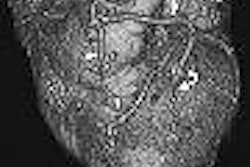SAN FRANCISCO - The debate over CT screening is unlikely to be resolved by any conclusive studies in the near future. That's the conclusion of participants in a debate over CT screening that took place this week at the International Symposium on Multidetector-Row CT, sponsored by Stanford University of Stanford, CA.
The discussion, which featured talks from experts Dr. Fergus Coakley of the University of California, San Francisco; Dr. Richard Webb, also of UCSF; and Dr. David Yankelevitz of the University of Cornell in Ithaca, NY, reviewed the current literature on CT screening with the goal of determining whether or not CT screening is advisable.
Perhaps the most critical issue is the importance of CT screening in lung cancer and whether early diagnosis means reduced mortality rates. While entrepreneurial imaging centers have sprung up touting whole-body screening of asymptomatic patients, the FDA and the American College of Radiology have adopted a more cautious approach and are even skeptical of the benefits of CT screening.
Does early diagnosis necessarily lead to better outcomes? According to Coakley, this may not necessarily be true, although most patients and doctors think so. A small tumor detected by screening may in fact be quite advanced biologically, and the stage of the tumor may be independent of its size, based on a study published in 1999 in Cancer.
"Tumor size may not be that important in prognosis, and certainly not in diagnosis," Coakley said. Rather, prognosis is determined by tumor aggressiveness.
In addition, figures on better outcomes after screening need to use specific disease mortality rates and not five-year survival rates, which could be misleading. Given a theoretical sample of four patients, two with slow-growing disease and two with rapidly advancing disease, screening was more likely to pick up people with slow-growing disease. So it was likely that the findings would have a length-time bias in which two out of three cases of cancer detected through screening would be indolent.
Lead-time bias, in which survival appeared better after screening diagnosis, and upward stage migration, were other sources of likely bias in findings. According to published data, the effectiveness of screening as measured by a decrease in mortality rates was 21% for mammography and 0% for chest x-ray, as opposed to 79% for Pap smear for the cervix and 44% for colonoscopy. In renal cell carcinoma, up to 61% of diagnosis was incidental and while the five-year survival rate was improving, the mortality rate was static with no decrease, according to a 1998 study in Urology.
According to the FDA, the estimated risk of fatal cancer from radiation of 10 milliSieverts was 1 in 2000, or 10 times more than the fatal risk associated with contrast. Terming this as shocking but plausible, Coakley said radiation risk was obscured by the difficulty in linking specific cancers to radiation dose, unlike contrast where the risk was more obvious.
Yankelevitz, who has been associated with the Early Lung Cancer Assessment program (ELCAP) since its inception, argued that screening over-diagnosis is not a bias but that "we have to learn what to do with these findings." He said that the remarkable developments in multislice CT over the last few years have made it possible to detect a greater number of abnormalities with the slice-thicknesses of 1 mm and thinner that are possible using today’s scanners.
Accordingly, the definition of a positive finding also needs to be changed, he added. Because of the scanner technology available today, it is possible to detect even 1-mm nodules in a healthy person. This should not be termed a positive finding. In the current scenario, he said he would term the presence of nodules of 5 mm and higher as a positive finding. And for nodules from 5 mm to 1 mm, he recommended a repeat screening in a year’s time.
On the debate over tumor size, he said it was obvious that size matters. "To convince me otherwise would require extraordinary evidence," he said.
Data from the Surveillance, Epidemiology and End Results (SEER) registry showed that was is a strong correlation between the size of the tumor and the stage of the cancer. This ratio would be even more favorable for screening data because a small tumor would not present itself in the registry unless it was symptomatic. In other words, there was a greater possibility that the small tumors presented in the registry were at a more advanced stage, compared to those detected through screening.
Webb said the advantage of screening CT is that low-dose spiral CT is more sensitive than chest radiographs for detecting lung cancer (with an sensitivity advantage of 4:1). And CT was six times as sensitive as chest radiography in detecting early-stage cancers, according to published studies.
Webb said that if more early-stage lesions were found with screening, but stage shifting did not occur, then it was likely that over-diagnosis bias was present. He called for balancing the risks of improved mortality after treatment in cancer patients and the risks of operative mortality in cancer patients, over-diagnosed patients, and patients with benign lesions.
By N. ShivapriyaAuntMinnie.com staff writer
June 25, 2004
Related Reading
Hiroshima revisited: Lung cancer screening raises lung cancer risk, June 24, 2004
Utility of CT screening for lung cancer remains unproven, June 1, 2004
CAD gets role in new ELCAP lung study, April 29, 2004
Radiologists offer new guidance on reducing CT radiation dose, August 14, 2003
Radiation doses in Hiroshima survivors confirmed, July 31, 2003
Radiation hormesis and the radiologic imperative, March 21, 2003
Copyright © 2004 AuntMinnie.com




















